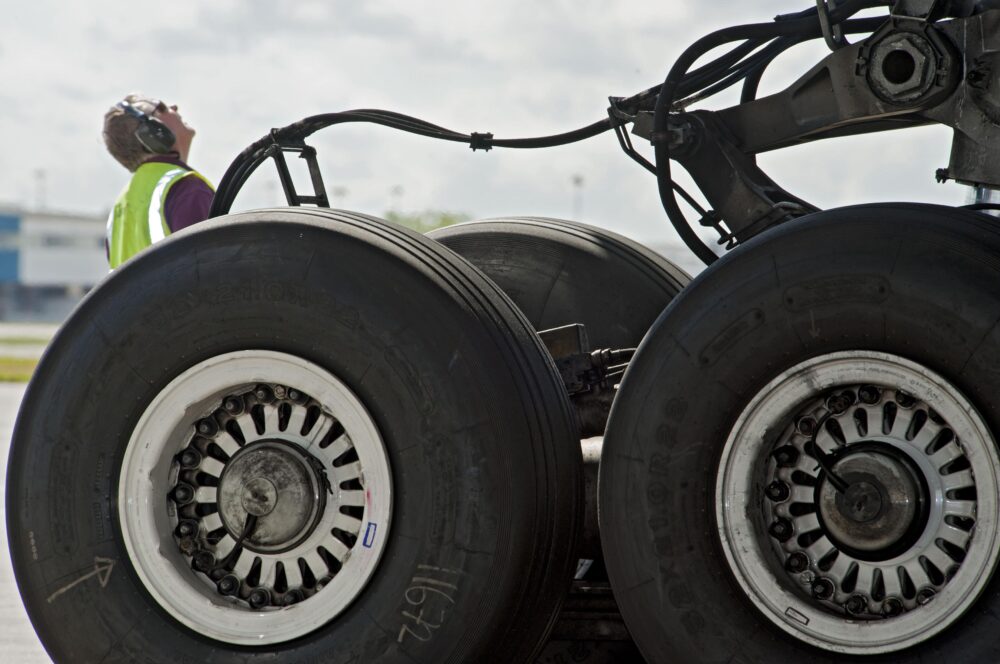No one would deny that the landing gear is a vital component of any aircraft. But how much attention do you pay to it when flying? Technology and safety have significantly improved in this area, but incidents still occur. Get up close, and these huge structures, supporting enormous weight and landing forces, are amazing pieces of engineering.

A vital part of the aircraft
The landing gear is one of the most critical aircraft components. As aviation has evolved, it has seen constant re-engineering and improvements. Writing about the importance of the landing gear in a whitepaper document, the consulting firm Infosys describes this importance and improvement in engineering:
“The need to design landing gear with minimum weight, minimum volume, reduced life cycle costs, and short development cycle time poses many challenges to landing gear designers and practitioners. These challenges have been met by employing advanced technologies, materials, analysis methods, processes, and production methods.”
Most landing gears are made by third-party suppliers, rather than by aircraft manufacturers themselves. Safran Landing Systems is one of the largest such companies, making landing gears for most Airbus aircraft, as well as the Boeing 787.
Stay informed: Sign up for our daily and weekly aviation news digests.
Absorbing the impact
The primary function of the landing gear is to absorb the force of landing and, of course, prevent the fuselage from hitting the ground. This force absorption happens in several ways. Firstly, the main landing gear strut has a shock absorption system, using compressible fluids. Secondly, the landing force is spread over a number of wheels.

Many smaller and medium-sized aircraft just have two-wheel landing gears (four wheels on each side in a 2-2 configuration). The larger Boeing 777 is notable for adding a third wheel to this. And most heavier aircraft, including the Airbus A340 and A380, and the Boeing 747 add an additional landing gear in the center of the fuselage.
For an extreme case, take a look at the vast Antonov An-225 aircraft. This has seven-wheel-long landing gears on each side.

Raising the landing gear
If you watch an aircraft take off, you will see that the gear is raised soon after leaving the runway. The landing gear structure is a significant source of drag, so raising it quickly is important when the aircraft needs to gain speed. Pilots will do this as soon as a ‘positive rate of climb’ is reached. Before this, the gear should remain down in case the aircraft descends back to the ground.

The landing gear is raised into a compartment in the fuselage. Some aircraft have doors that close over the gear, which protects the gear structure and also ensures the aerodynamic of the aircraft. Others, like the 737 above, retract into a cavity in the aircraft’s belly.
Although things differ from aircraft to aircraft, Virgin Atlantic outlined how things work on its A330. In this case, the gear retraction (and extending for landing) is computer-controlled by Landing Gear Control and Interface Units. All aircraft have backup gear systems as well. The A330 has two independent control systems, alternated in use each time the gear is activated. The Boeing 747 has four separate hydraulic systems, for example.
As the gear is raised, it will often shorten to take up less space in the fuselage compartment. On the A330 this is achieved by retracting the shock absorbers in the landing gear strut.
And lowering it for landing
The gear is lowered for landing once the airspeed reaches a designated level (this is 280 knots on the A330, for example). Doing so before this could damage the gear, and it is usually prevented. Lowering is controlled by the same dual computer system. There is a further backup system in case the hydraulic systems fail. On the A330, this is gravity-assisted, using electromagnets. Older aircraft may even have had a manual handle to lower the gear.

Ensuring that the gear is lowered correctly and locked before landing has always been vital. These days, this is indicated by the computer unit using lights in the cockpit. There is usually a secondary, independent system indicating this as well.
It is not that long ago that it was also possible to check this visually. Many older Boeing 737 aircraft, as described on The Boeing 737 Technical Site, have a viewing periscope in the fuselage above the main landing gear. This was discontinued from the 737 NG Series when an independent indicator backup system was introduced.
Problems with landing gears
Despite improvements in technology and numerous backup systems, emergency incidents involving the landing gear do happen. With so many moving parts and hydraulic systems in play, risk remains. Fortunately, there are cases of aircraft landing successfully despite problems. These so-called ‘belly landings’ are, of course, very dangerous, though, and even if successful, will cause extensive damage to the aircraft.
Simple Flying regularly reports aircraft incidents involving landing gears. In March 2020, for example, a Virgin Atlantic Airbus A330 was forced to return to London Heathrow after its landing gear failed to retract. And just the month before that, the main landing gear collapsed on an Icelandair Boeing 757 at Keflavik International Airport.

Some prominent significant emergencies include a JetBlue Airbus A320 in 2005, which landed at Los Angeles International Airport with a nose gear stuck at the wrong angle. And in 2011, a LOT Polish Airlines Boeing 767 landed at Warsaw Chopin Airport with complete landing gear failure, after the hydraulic system failed.
The landing gear is a critical part of all aircraft, but not something we often write about. Feel free to share or discuss any different systems, or interesting facts you are aware of, in the comments.
[ad_2]
Source link

